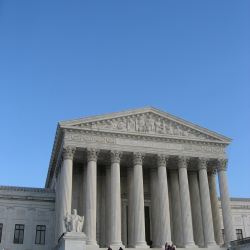The issue of reproductive rights, calls for informed citizenship, urging understanding of pivotal issues, particularly those under the scrutiny of the Supreme Court. The approval of Mifepristone involves medical advancements, legal complexities, and the enduring tension between societal norms and legislative restrictions.
I can think of few other issues, so personal as the decisions we make at the beginning and end of life. I am not taking a personal position because, quite frankly, it is none of your business. But to be good citizens, we must understand the issues before our Courts, especially the Supreme Court. This is an effort to provide the information regarding mifepristone currently coming to the Supreme Court. How does that saying go, "We report, you decide."
“What you’re asked to do is look at the evidence presented to you and make a decision.”
- Jane Henney, FDA commissioner of the FDA when Mifepristone was approved
And that is precisely what an FDA panel did in 2000 to approve Mifepristone.
An Abundance Of Caution
At the time of Mifepristone’s approval, the FDA had no mechanism for restricting the use of drugs after approval. [1] The Guttmacher Institute, a “research and policy organization committed to advancing sexual and reproductive health and rights,” authored a peer-review of Mifepristone at the time of FDA approval, concluding:
“The European experience suggests that early medical abortions can be safely performed at later gestations and under simpler protocols than the one approved by the FDA.”
Despite the data from Europe and what we have come to see as an “abundance of caution,” the original approval required
- In-person administration with a physician in attendance was used to ensure it was taken correctly, and follow-up appointments were made to evaluate its efficacy and adverse effects. [2]
- It was only approved “for use up until seven weeks of pregnancy.”
Over the next 20 years, those conditions were relaxed, with the approved use extending to 10 weeks and no in-person visits required. [3]
A study reported in Acta Obstetrics Gynecology Scandinavia, typical of what might be currently found in the literature, looked at “1018 women requesting abortion before 63 days’ gestation.” 93.6% of the women had no problems with treatment, and 5% of women required surgical intervention, two-thirds of which was due to prolonged bleeding.
A more contemporaneous study published in Lancet Regional Health America looked at roughly 3200 women undergoing medical abortion using Mifepristone, prescribed by telemedicine.
“Overall, 96.4% of those who used the medications reported successfully ending their pregnancy without surgical intervention, and 1.0% reported treatment for any serious adverse event.”
“Throwing caution to the wind.”
In their argument before the Supreme Court, the Alliance For Hippocratic Medicine, an umbrella group of anti-abortion activists, contends that the FDA relaxation of standards was wrong because
“not a single study that FDA relied on examined what would happen if the agency removed every safeguard at once.
…
In allowing for mail-order abortions, FDA relied heavily on its Adverse Event Reporting System (FAERS). But FDA abandoned reporting requirements for nonfatal adverse events years before.”
Finally, they argue for an old federal law still on the books.
“[The] FDA violated the Comstock Act—a longstanding federal criminal law that prohibits the mailing, shipping, or delivery of “[e]very” and “any drug … designed, adapted, or intended for producing abortion.”
“Those who cannot remember the past are condemned to repeat it.”
The Comstock Act is a real-world example of this axiom of George Santayana, As Wikipedia reports, the Comstock Acts were a series of laws passed during the Grant administration criminalizing the use of the US Postal Service to send
“any of the following items: obscenity, contraceptives, abortifacients, sex toys, personal letters with any sexual content or information, or any information regarding the above items.”
The law was extended to other forms of interstate common carriers. Until the current case, the restrictions on birth control had been voided by two Supreme Court decisions.
- Griswold v. Connecticut (1965) - protects the liberty of married couples to use contraceptives without government restriction
- Eisenstadt v. Baird (1972) – extending those liberties to unmarried individuals
In 1971, Congress removed the restrictions on contraception but left those on “abortifacients” intact, raising the fine from $5,000 to $250,000 for a first offense. Dobbs has reopened the door.
The decision surrounding Mifepristone reflects the interplay between medical advancements, legal frameworks, and reproductive rights in the United States. The shifting landscape from stringent in-person requirements to telemedicine-prescribed alternatives has sparked debates, with advocates highlighting improved accessibility and safety, while opponents question the potential risks and the FDA's decision-making process. The mention of the Comstock Act adds a historical layer, underscoring the enduring tension between evolving societal norms and legislative restrictions. The ongoing legal challenges signal a reexamination of established norms.
[1] The Risk Evaluation and Mitigation Strategy (REMS) program expanded FDA post-marketing control seven years later.
[2] “the Day 1 in-person dispensing and administration of mifepristone, (2) the Day 3 in-person dispensing and administration of misoprostol, and (3) the Day 14 office visit to confirm no fetal parts or tissue remains.”
[3] “(1) increased the maximum gestational age from seven weeks to ten, (2) allowed non-doctors to prescribe and administer chemical abortions, (3) decreased the mifepristone dose from 600 mg to 200 mg, (4) increased the misoprostol dose from 400 mcg to 800 mcg, (5) amended the misoprostol administration period from 48 hours to 24–48 hours, (6) allowed a repeat 800 mcg dose of misoprostol, (7) switched to buccal administration of misoprostol, (8) removed the Day 3 in-person administration requirement for misoprostol, (9) eliminated the Day 14 in-person follow-up examination to identify complications, and (10) removed the requirement that prescribers report non-fatal adverse events.”
Source: FDA protocols originally intended to be extra conservative are now heralded as evidence of Mifepristone’s risk Stat

